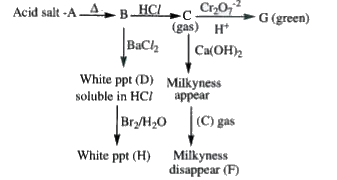Na2S2O3 may react with the compound given in Column-I, Na2S2O3 exhibits the properties of the type give in the coloumn-II, matter the reactants given in column-I with the type of property, properties given in Column-II
COLUMN-ICOLUMN-II(A)SO2(p)turns acidified K2Cr2O7 solution green(B)CO2(q)turns blue is Red(C)H2S(r)turns lime water milky(D)H2O2(s)used for restoring old paintings in the museums Solution in Telugu
A) K2Cr2O7+3SO2+H2SO4→K2SO4+Cr2(SO4)3Green+H2O
Ca(OH)2+SO2→CaSO3milky+H2O
In aqueous solution it acts as an acid turns moist litmus red.
B) H2O+CO2→H2CO3Carbonic acidTurns blue to redCa(OH)2+CO2→CaCO3↓Milky white ppt
C) K2Cr2O7+4H2SO4+3H2S→K2SO4+Cr2(SO4)3+7H2O+3S
Aqeuous solution H2S acidic because it is a weak dibasic acid.
H2S+H2O→H3O++S2−
D) The equation used for restoring of old oil painting in the museums.
PbS+4H2O2→PbSO4+4O2
Topper's Solved these Questions
- VIA GROUP ELEMENTSBOOK - AAKASH SERIESCHAPTER - VIA GROUP ELEMENTSEXERCISE - PRACTICE SHEET - 4 (Integer answer type Questions)
2 Videos
- VIA GROUP ELEMENTSBOOK - AAKASH SERIESCHAPTER - VIA GROUP ELEMENTSEXERCISE - PRACTICE SHEET - 5 (Linked Comprehension type questions)
3 Videos
- VIA GROUP ELEMENTSBOOK - AAKASH SERIESCHAPTER - VIA GROUP ELEMENTSEXERCISE - PRACTICE SHEET - 4 (Linked Comprehension type questions)
6 Videos
- VA GROUP ELEMENTSBOOK - AAKASH SERIESCHAPTER - VA GROUP ELEMENTSEXERCISE - PRACTICE EXERCISE
51 Videos
- VII GROUP ELEMENTSBOOK - AAKASH SERIESCHAPTER - VII GROUP ELEMENTSEXERCISE - OBJECTIVE EXERCISE -4
55 Videos
Similar Questions
Sulphuric acid acts as a powerful dehydrating agent. How many no of carbons are formed when glucose molecule is dehydratred by H2SO4 as reagent
View SolutionPassage-II:

'C' is
View SolutionPassage - I :

Yellow solid 'A' is
View SolutionWhich of the following reacts rapidly with oxygen in the air at ordinary temperature?
View Solution(A): The bond dissociation energy of fluorine is less than bromine.
(R): In fluorine molecule, large lone pair electronic repulsions and appreciable internuclear repulsions are present.
View SolutionMatch the column -
Column-IColumn-IIFor the production of H2O2(A)Down process(p)K2CO3(B)Solvay process(q)Manufacture of Na(C)Leblance process(r)Manufacture of NaOH(D)Castner- K ellner cell(s)Na2CO3
View SolutionMatch the following : H_(2)O_(2) reacts with compounds of column-I
View SolutionNa_(2)S_(2)O_(3) may react with the compounds given in coloum I. Na_(2)S_(2)O_(3) exhibits the properties of the type given in the coloum II, match the reactants given in coloum I with the type of property/properties given in coloum II. {:(,"Column I(reactant)",,"Coloumn II(type of property shown)"),("a)",Cl_(2),,"p) complexing agent"),("b)",AgBr,,"q) dispropotionation"),("c)","HCl",,"r) only as reductant"),("d)",I_(2),,"s) an antichlor"):}
View SolutionA gas turns lime water milky and acidified K2Cr2O7 solution green then gas is :
View SolutionMatch the Following : {:(" Column I"," Column II"),(" (Addition of dil. HCl/dil "H_(2)SO_(4)")"," (Observation)"),("(A) "S_(2)O_(3)^(2-),"(p) Gas evolved turns lime water milky"),("(B) "SO_(3)^(2-),"(q) Gas turns lead acetate paper black"),("(C) "CO_(3)^(2-),"(r) Gas turns acidified "K_(2)Cr_(2)O_(7)" solution green"),("(D) "S^(2-),"(s) Gives white turbidity"):}
View SolutionMatch the species in Column I with the bond order in Column II {:(" Column I Column II " ),((i) NO " (a)" 1.5),((ii) CO" (b)" 2.0),((iii)O_(2)^(-)" "(c) 2.5),((iv) O_(2)" (d)" 3.0):}
View SolutionMatch the entires of Column I with appropiate entires of column II and choose the correct option out of the four option (a) ,(b) ,(c ) (d) given at the end of each question
column I (Compound)column II (Oxidation numbers of S atoms)(A)Na2S2(p)+6(B)Na2S2O3(q)−1−1(C)Na2S(2)O7(r)+6+6(D)H2SO4(s)−2+4
View SolutionMatch the entires of Column I with appropiate entires of column II and choose the correct option out of the four option (a) ,(b) ,(c ) (d) given at the end of each question
column I (Compound)column II (Oxidation numbers of S atoms)(A)Na2S2(p)+6(B)Na2S2O3(q)−1−1(C)Na2S(2)O7(r)+6+6(D)H2SO4(s)−2+4
View SolutionMatch Column -I with Column -II {:("Column-I","Column-II"),((A)"Sorel's cement",(p)MgCl_(2)),((B)"Albite",(q)MgO),(( C)"A salt of carnallite",( r) NaAlSl_(3)O_(8)),((D)"Glauber's salt",(s) Na_(2)SO_(4).10H_(2)O):}
View SolutionMatch the molecular species in Column-I and their magnetic and molecular orbital properties in Column-II :
Column-IColumn-II(A)O2(P)Bond order = 2 (B)N2(Q)Oiamagnetic (C)H2(R)Bond order= 3(D)O2−2(S)Paramagnetic
View Solution{:("COLUMN-I","COLUMN-II"),((A)"Crown shape",(p)S_(2)Cl_(2)),((B)"Angular shape",(q)S_(8)" molecule"),((C )"Planar trigonal",(r )O_(3)" molecule"),((D) H_(2)O_(2)" like structure",(s) SO_(3)" molecule"):}
View Solution